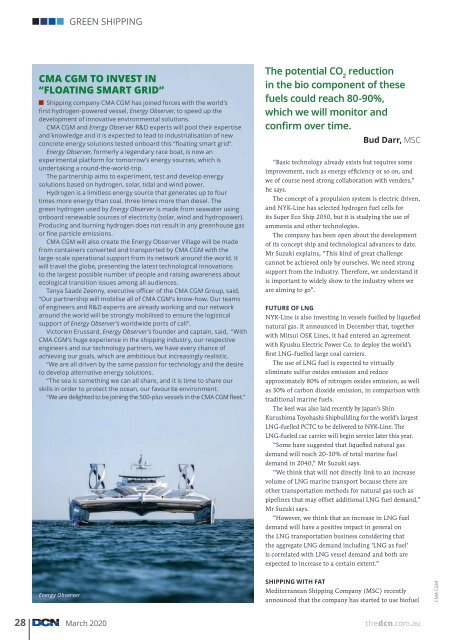DCN March Edition 2020
You also want an ePaper? Increase the reach of your titles
YUMPU automatically turns print PDFs into web optimized ePapers that Google loves.
GREEN SHIPPING<br />
CMA CGM TO INVEST IN<br />
“FLOATING SMART GRID”<br />
Shipping company CMA CGM has joined forces with the world’s<br />
first hydrogen-powered vessel, Energy Observer, to speed up the<br />
development of innovative environmental solutions.<br />
CMA CGM and Energy Observer R&D experts will pool their expertise<br />
and knowledge and it is expected to lead to industrialisation of new<br />
concrete energy solutions tested onboard this “floating smart grid”.<br />
Energy Observer, formerly a legendary race boat, is now an<br />
experimental platform for tomorrow’s energy sources, which is<br />
undertaking a round-the-world-trip.<br />
The partnership aims to experiment, test and develop energy<br />
solutions based on hydrogen, solar, tidal and wind power.<br />
Hydrogen is a limitless energy source that generates up to four<br />
times more energy than coal, three times more than diesel. The<br />
green hydrogen used by Energy Observer is made from seawater using<br />
onboard renewable sources of electricity (solar, wind and hydropower).<br />
Producing and burning hydrogen does not result in any greenhouse gas<br />
or fine particle emissions.<br />
CMA CGM will also create the Energy Observer Village will be made<br />
from containers converted and transported by CMA CGM with the<br />
large-scale operational support from its network around the world. It<br />
will travel the globe, presenting the latest technological innovations<br />
to the largest possible number of people and raising awareness about<br />
ecological transition issues among all audiences.<br />
Tanya Saadé Zeenny, executive officer of the CMA CGM Group, said,<br />
“Our partnership will mobilise all of CMA CGM’s know-how. Our teams<br />
of engineers and R&D experts are already working and our network<br />
around the world will be strongly mobilised to ensure the logistical<br />
support of Energy Observer’s worldwide ports of call”.<br />
Victorien Erussard, Energy Observer’s founder and captain, said, “With<br />
CMA CGM’s huge experience in the shipping industry, our respective<br />
engineers and our technology partners, we have every chance of<br />
achieving our goals, which are ambitious but increasingly realistic.<br />
“We are all driven by the same passion for technology and the desire<br />
to develop alternative energy solutions.<br />
“The sea is something we can all share, and it is time to share our<br />
skills in order to protect the ocean, our favourite environment.<br />
“We are delighted to be joining the 500-plus vessels in the CMA CGM fleet.”<br />
The potential CO 2<br />
reduction<br />
in the bio component of these<br />
fuels could reach 80-90%,<br />
which we will monitor and<br />
confirm over time.<br />
Bud Darr, MSC<br />
“Basic technology already exists but requires some<br />
improvement, such as energy efficiency or so on, and<br />
we of course need strong collaboration with venders,”<br />
he says.<br />
The concept of a propulsion system is electric driven,<br />
and NYK-Line has selected hydrogen fuel cells for<br />
its Super Eco Ship 2050, but it is studying the use of<br />
ammonia and other technologies.<br />
The company has been open about the development<br />
of its concept ship and technological advances to date.<br />
Mr Suzuki explains, “This kind of great challenge<br />
cannot be achieved only by ourselves. We need strong<br />
support from the industry. Therefore, we understand it<br />
is important to widely show to the industry where we<br />
are aiming to go”.<br />
FUTURE OF LNG<br />
NYK-Line is also investing in vessels fuelled by liquefied<br />
natural gas. It announced in December that, together<br />
with Mitsui OSK Lines, it had entered an agreement<br />
with Kyushu Electric Power Co. to deploy the world’s<br />
first LNG-fuelled large coal carriers.<br />
The use of LNG fuel is expected to virtually<br />
eliminate sulfur oxides emission and reduce<br />
approximately 80% of nitrogen oxides emission, as well<br />
as 30% of carbon dioxide emission, in comparison with<br />
traditional marine fuels.<br />
The keel was also laid recently by Japan’s Shin<br />
Kurushima Toyohashi Shipbuilding for the world’s largest<br />
LNG-fuelled PCTC to be delivered to NYK-Line. The<br />
LNG-fueled car carrier will begin service later this year.<br />
“Some have suggested that liquefied natural gas<br />
demand will reach 20-30% of total marine fuel<br />
demand in 2040,” Mr Suzuki says.<br />
“We think that will not directly link to an increase<br />
volume of LNG marine transport because there are<br />
other transportation methods for natural gas such as<br />
pipelines that may offset additional LNG fuel demand,”<br />
Mr Suzuki says.<br />
“However, we think that an increase in LNG fuel<br />
demand will have a positive impact in general on<br />
the LNG transportation business considering that<br />
the aggregate LNG demand including ‘LNG as fuel’<br />
is correlated with LNG vessel demand and both are<br />
expected to increase to a certain extent.”<br />
Energy Observer<br />
SHIPPING WITH FAT<br />
Mediterranean Shipping Company (MSC) recently<br />
announced that the company has started to use biofuel<br />
CMA CGM<br />
28 <strong>March</strong> <strong>2020</strong><br />
thedcn.com.au
















